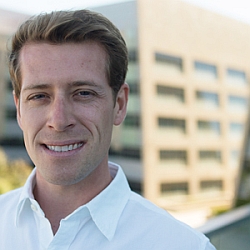
Michael Keiser (UC-San Francisco)
Researchers at University of California in San Francisco, with colleagues from San Francisco start-up SeaChange Pharmaceuticals and the drug company Novartis, have devised a computer model that predicts adverse reactions to drug compounds, based on the chemistry of the drugs and known molecular causes of side effects. The team?s findings appear online in the journal Nature (paid subscription required).
Michael Keiser (pictured right), co-lead author of the paper, is one of the founders of SeaChange, started in 2009 to commercialize research conducted in the lab of UCSF?s Brian Shoichet, a professor of pharmaceutical chemistry and also a SeaChange founder. Eugen Lounkine, a postdoctoral fellow at Novartis, is the paper?s other lead author.
The paper notes that adverse effects of drugs is the second leading cause of drugs failing in clinical trials, behind lack of effectiveness. To give drug designers better tools to better understand the probability of adverse drug reactions, the researchers developed algorithms for predicting unintended side effects before getting into lengthy and expensive clinical trials.
The project used the technology developed in Shoichet?s UCSF lab, called similarity ensemble approach, that compares the shape of each drug to thousands of other compounds and uses those comparisons to predict to which proteins the drug might bind. With this approach, the SeaChange and UCSF researchers screened the activity of 656 currently marketed drugs on 73 protein targets appearing on Novartis?s safety panel for testing drugs for side effects. At the same time, Novartis developed a statistical technique for relating those targets to known side effects.
The computer model identified 1,241 possible side-effect targets for the 656 drugs. Of those potential side-effects, 348 targets were confirmed in Novartis?s drug-interactions database. However, the model also identified another 151 side effects that were previously not connected to these 656 drugs. Novartis later confirmed these side effects in follow-up lab tests.
One of the drugs screened was a synthetic form of estrogen, known to cause stomach pain, but with few explanations for why the pains occur. The model used in the screen showed that the synthetic estrogen binds strongly to the protein target COX-1, a target of non-steroidal anti-inflammatory drugs, such as aspirin, which also can cause stomach pain, ulceration, and bleeding.
The model ?gives you a computerized safety panel,? says Keiser, ?so someday, when you?re deciding among hundreds of thousands of compounds to pursue, you could run a computer program to prioritize for those that may be safest.?
Read more:
*???? *???? *
derrick rose torn acl pacers undrafted free agents braveheart james harden earthquake california earthquake california
No comments:
Post a Comment